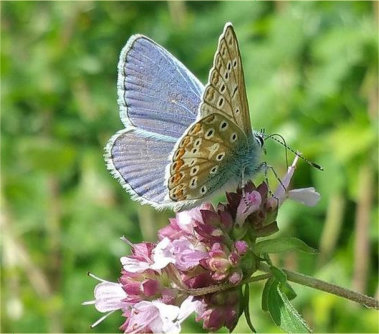
Article from the Hayling Island Horticultural Society
Martin Hampton delivered a talk at our recent monthly meeting that was so informative and illuminating that we would like to share some of his key ideas with you, with the hope that you might be able to put some of these into practice in your own garden.
His mission is to inform about our precious wildlife and how we gardeners can all play a part in saving it. Martin is a former teacher and lecturer and specializes in ecologically informed garden design and practice, with a focus on mixed perennial planting, wildlife ponds and gardening for bees, butterflies and birds.

He starts from the standpoint that ornamental gardens are really only a recent phenomenon ie the last 150 years! Prior to that the landscape remained as nature intended or was just focused on the production of food. Martin challenged our preconceived ideas that we need to have a tidy garden, cut our grass, remove weeds and cut back unwanted plants – dandelions for example are a vital source of food.
His main argument was against the most recent idea of creating meadows using expensive seed mixes. If we are successful they look very pretty but the best meadows for wildlife are just letting nature take its course in a part of our garden space. The best plants for butterflies are grasses and stinging nettles. Without stinging nettles, the caterpillars have nothing to feed on. We do not need to feed the birds artificial food for most of the year if we look after the plants and soil to provide the insects and small animals they need.
Martin stressed the importance of maintaining the biodiversity of the soil by avoiding artificial feeds and pesticides and certainly not using weed suppressant fabric which he described as ‘biocide’. We should strive to leave as many dead and dying things in our garden as possible and they provide the best habitat for worms, millipedes, beetles, flies, bees and crane-flies and host of other wildlife.
Some of the best plants which provide a habitat for herbivorous insects are poplars and willows, oaks, hawthorn, holly, hazel and buckthorn (this is the only plant that the yellow ‘Brimstone’ butterflies feed on). Painted Lady butterflies mainly feed on thistles and the common blue butterfly likes ‘Eggs and Bacon’ (Bird’s Foot Trefoil) which is a very important nectar rich plant which we all have growing somewhere in our gardens.
Perennial plants which benefit wildlife are grasses, mint, clover, vetches and trefoils, proper geraniums, violets, salvia and valerian, thistles and scabious, to provide a few examples. He also stressed we should avoid over over lighting our gardens and this discourages wildlife.
Martin emphasised that we can have the best of both worlds with some cultivated and ornamental aspects to our gardens but to also think about incorporating some of the ideas above which can also look very attractive. As we keep repeating ‘a plant is only a weed in the wrong place’ You may not agree, but we hope this has given you all food for thought.
See the ‘What’s On’ pages for our events programme.
Visit our website: www.hihs.org.uk or email us on admin@hihs.org.uk